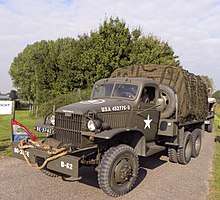American logistics in the Northern France campaign
American logistics in the Northern France campaign played a key role in the success of Operation Overlord, the Allied invasion of northwest Europe during World War II that commenced on D-Day, 6 June 1944. On 25 July 1944, the First United States Army began Operation Cobra, the breakout from Normandy. The advance was much faster than expected and the rapid increase in the length of the line of communications threw up unanticipated logistical challenges. The logistical plan lacked the flexibility needed to cope with the rapidly changing operational situation, and the rehabilitation of railways and construction of pipelines could not keep up with the pace of the advance, and air supply had limited capacity. Major shortages developed, particularly of petrol, oil and lubricants (POL). Motor transport was used as a stopgap, and the Advance Section (ADSEC) organized the Red Ball Express, which delivered supplies from the Normandy lodgment area, but at great cost in wear and tear, and accidental damage.

Senior commanders subordinated logistical imperatives to operational opportunities. Two decisions in particular had long-term and far-reaching effects. The decision to abandon plans to develop the ports of Brittany left the American forces with only the port of Cherbourg and the Normandy beaches for their maintenance. The subsequent decision to continue the pursuit beyond the Seine led to the attrition of equipment, failure to establish a proper supply depot system, neglect of the development of ports, inadequate stockpiles in forward areas, and a shortage of POL as increased German resistance stalled the American advance. The difficulties were exacerbated by the poor supply discipline of the American soldier. While the logistical system had facilitated a great victory, these factors would be keenly felt.
Background
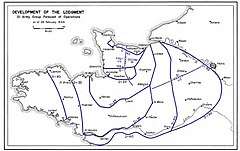
After the American entry into World War II in December 1941, the European Theater of Operations, United States Army (ETOUSA) was formed, with a Services of Supply (SOS) organization under Major General John C. H. Lee.[1] After General Dwight D. Eisenhower became the Supreme Commander, Allied Expeditionary Force, on 16 January 1944, ETOUSA and SOS were combined into a single headquarters,[2] which was increasingly referred to as the Communications Zone (COMZ),[3] although this did not become official until 7 June.[4]
To support Operation Overlord, the invasion of Normandy, COMZ activated two subordinate headquarters, the Forward Echelon, Communications Zone (FECOMZ), under Brigadier General Harry B. Vaughan, with Colonel Frank M. Albrecht as his chief of staff, and the Advance Section (ADSEC), under the command of Colonel Ewart G. Plank. ADSEC would take over the operation of base areas, supply dumps and communications from the First Army as it moved forward. In the initial stages of Overlord, ADSEC would be attached to the First Army.[5][6]
The Overlord plan called for the capture of Cherbourg by D plus 8 (8 days after D-Day),[7] and a rapid American advance to secure the Brittany ports and develop Quiberon Bay (Operation Chastity). Crucially, the logistical plan called for a one-month pause at the Seine River, which was expected to be reached by D plus 90, before advancing further.[8] The expectation of an advance at a proscribed rate, while necessary for planning purposes, built inflexibility into a logistics plan that already had little margin for error. Staff studies confirmed that Overlord could be supported if everything went according to plan. No one expected that it would.[9]
The First Army was supported over the Omaha and Utah Beaches, and through the Mulberry artificial port at Omaha specially constructed for the purpose, but the American Mulberry was abandoned after it was damaged by a storm on 19 June.[10] During the first seven weeks after D-Day, the advance was much slower than the Operation Overlord plan had anticipated, and the lodgment area therefore very much smaller. The nature of the fighting in the Normandy hedgerow (bocage) country created shortages of certain items, particularly artillery and mortar ammunition, and there was unexpectedly high rates of loss of bazookas, Browning automatic rifles (BARs), and M7 grenade launchers.[11]
Breakout and pursuit
Operation Cobra, which commenced on 25 July 1944, effected a remarkable turnaround in the operational situation. That day Eisenhower ordered a regrouping of the US forces in Normandy. The 12th Army Group became active on 1 August.[12] Its headquarters was formed by renaming the First United States Army Group, but on paper it remained in the UK under the command of Lieutenant General Lesley J. McNair as part of Operation Fortitude, a deception operation aimed at convincing the Germans to maintain forces outside Normandy.[13] The 12th Army Group consisted of the First Army, commanded by Lieutenant General Courtney Hodges, and the Third Army, under the command of Lieutenant General George S. Patton Jr. Lieutenant General Omar N. Bradley commanded the 12th Army Group, but until Eisenhower could open his Supreme Headquarters, Allied Expeditionary Force (SHAEF) in France, British General Bernard Montgomery remained in command of all ground forces on the continent, channeling his orders to the US forces through the 12th Army Group.[12] SHAEF did not assume direct command of the ground forces until 1 September.[14]

By 3 August, Patton's Third Army was advancing into Brittany.[15] Bradley fixated on Brest, which was only intended to be a port of reception for troops, and Saint-Malo, a minor port, whereas Patton focused on Lorient and Quiberon Bay. There were significant differences in the way Patton, a cavalryman, and Bradley and the VIII Corps commander, Major General Troy H. Middleton, who were both infantrymen, conceived operational art. When the 4th Armored Division's commander, Major General John S. Wood incorrectly reported that Lorient was too strongly defended to rush, Middleton accepted this assessment.[16][17]
Bradley then ordered Patton to move east, leaving only minimal forces in Brittany.[15] This did not immediately change the plan;[15] Eisenhower informed Marshall that "the rapid occupation of Brittany is placed as a primary task, the difference being that in one case we believe that it would rather easily be done and in the other we would have to fight through the defensive line and commit more forces to the job"[18] But it was the first in a series of critical decisions that subordinated logistical considerations to short-term operational advantage.[15] In the event, Lorient was not captured, and as a result Quiberon Bay could not be developed because the approaches were not cleared. Saint-Malo was secured on 2 September,[19] and Brest on 19 September, but the port facilities were destroyed,[16][20] and SHAEF had abandoned plans to develop Quiberon Bay on 3 September.[21]
By 24 August, the left bank of the Seine had been cleared, and Operation Overlord was completed. In just 30 days, the Allied forces had conducted an advance that had been expected to take 70. Reaching the D plus 90 line on D plus 79 was not a grave concern, as the Overlord plan had sufficient flexibility to allow for a discrepancy of eleven days.[22] The plan called for a pause on the Seine of at least 30 days, but in mid-August the decision was taken to continue the pursuit beyond the Seine. This had even more far-reaching effects than Bradley's 3 August decision.[23] Between 25 August and 12 September, the Allied armies advanced from the D plus 90 phase line to the D plus 350 one, moving through 260 phase lines in just 19 days. Although the planners had estimated that no more than 12 divisions could be maintained beyond the Seine, 16 were by mid-September, albeit on reduced scales.[24]
Base organization
ADSEC headquarters opened in Normandy on 16 June. FECOMZ, now under Albrecht's command, opened its headquarters at Château Servigny and Château Pont Rilly near Valognes on 15 July, but ADSEC remained subordinated to the First Army until 30 July. Indeed, the First Army controlled all US forces in France until 1 August, when the 12th Army Group and the Third Army became active.[25] The facilities at Valognes were greatly expanded, with tents to accommodate 11,000 personnel and 560,000 square feet (52,000 m2) of hutted office space,[26] and special signal facilities installed to enable it to communicate with the UK and US.[25] COMZ headquarters opened at Valognes on 7 August,[27] a month earlier than originally planned, and FECOMZ therefore never operated in its intended role.[28]

COMZ headquarters was not destined to remain at Valognes for long, for on 1 September it began moving to Paris. As Paris was the hub of road, rail, cable and inland waterway systems, it soon hosted a concentration of supply depots, hospitals, airfields, railway stations and marshaling yards, and inland waterway offloading points, and as such was the logical and perhaps the only suitable location for COMZ headquarters. The move took two weeks to accomplish,[26] with some of the 29,000 staff moving directly from the UK, and consumed motor and air transport at a time when transportation assets were scarce.[29] COMZ headquarters occupied 167 Paris hotels. Eisenhower was not impressed; the move had been conducted without his knowledge, and contrary to his orders that no Allied headquarters be located in Paris without his specific approval.[30]
On 11 July, ADSEC organized the port of Cherbourg as Area No. 1 under the command of Colonel Cleland C. Sibley, the commander of the 4th Major Port. Ten days later it was redesignated the Cherbourg Command, with Colonel Theodore Wyman Jr. in charge. Over the following week, his headquarters was reinforced with personnel from Base Section No. 3 in England. It was redesignated the Cherbourg Base Section on 7 August, and began taking over the beach area dumps from ADSEC. Finally, on 16 August, it became the Normandy Base Section. Meanwhile, Colonel Roy W. Growler's Base Section No. 1 had arrived at Utah Beach on 3 August, and proceeded to Rennes, where it opened as the Brittany Base Section on 16 August. Brigadier General Leroy P. Collins's Base Section No. 1 moved to Le Mans, where it became the Loire Base Section on 5 September. After Paris was captured, COMZ sent for Brigadier General Pleas B. Rogers's Base Section No. 5, which had been specifically created for the role. It became the Seine Base Section on 24 August,[31] and occupied another 129 Paris hotels.[30]
Base Section No. 4, under the command of Colonel Fenton S. Jacobs, opened at Fontainebleau on 3 September as the Oise Section, and a Channel Base Section was formed under Colonel Charles O. Thrasher. Before either became operational, it was realized that each was better suited to the other's mission, so the two swapped names and roles on 15 September. At the same time the engineering section of the Brittany Base Section, which had been organized with the mission of rehabilitating ports, was transferred to the Channel Base Section. With the departure of the sections and most of the personnel from the UK, the sections there became districts, and were consolidated into the UK Base Section, under Vaughan's command.[31]
A key element of a functional logistics system was the establishment of a series of depots. ADSEC was only authorized to maintain stocks sufficient to supply the daily needs of the armies, with its depots replenished by automatic shipment or requisitions from COMZ. The restricted size of the Normandy lodgment area necessarily resulted in a crowding of the installations, and this problem was compounded by the First Army's reluctance to release the dumps under its control until the end of July. The First Army then became the main sufferer from the consequent logistical problems.[32]
Once the breakout began in earnest, the distances soon became prohibitive for the armies' own transport resources. The Third Army's line of communication ran from the beaches to Laval, 135 miles (217 km) distant, and then to Le Mans, another 175 miles (282 km) away. ADSEC opened a transfer point at Laval on 13 August, and then one at Le Mans a week later. ADSEC hoped to develop Le Mans as a major supply area, but soon it was too far from the front. The transfer point was moved to Ablis, 20 miles (32 km) east of Chartres, where another attempt was made to establish a major depot area. The transfer point remained at Ablis until 7 September, by which time the Third Army was operating beyond the Moselle, 200 miles (320 km) away.[33]
POL

The supply of MT80 (80 octane gasoline used by vehicles and generators) was adequate for the first month of Operation Cobra, although the Third Army had only meager reserves and depended on daily deliveries. On 3 August it had 515,000 US gallons (1,950,000 l) on hand, representing 1.3 days of supply. In contrast, the First Army held 10.5 days of supply. In view of this disparity, action was taken to reduce the First Army's excess stocks, and by 19 August they had been reduced to 3.9 days of supply. During the week of 20–26 August, with both armies engaged in pursuit of the retreating Germans, consumption soared, with the First Army burning an average of 501,000 US gallons (1,900,000 l) per day (782,000 US gallons (2,960,000 l) on 24 August alone), and the Third Army using 350,000 US gallons (1,300,000 l). By 3 September, both armies reported that they had less than a day's supply on hand.[34]
Meanwhile, as the distances increased the difficulty involved in delivering POL steadily mounted. The Third Army began rationing MT80. On 28 August, the Third Army reported that receipts had fallen 97,510 US gallons (369,100 l) short of its 450,000 US gallons (1,700,000 l) requirements. Deliveries fell to 31,975 US gallons (121,040 l) on 30 August, and 25,390 US gallons (96,100 l) on 2 September. One additional source was captured fuel; 115,000 US gallons (440,000 l) was captured at Châlons-du-Maine on 29 and 30 August, and the Third Army made use of 500,000 US gallons (1,900,000 l) during the pursuit. It also commandeered the fuel that trucks needed for their return journeys, leaving convoys stranded. Yet at no stage was fuel actually in short supply; on 19 August the depots in Normandy held 27,000,000 US gallons (100,000,000 l) of gasoline, equivalent to twelve days of supply. The problem was one of distribution.[34]
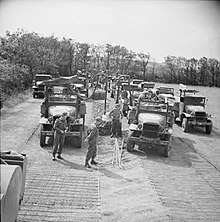
The preferred method of moving bulk POL was through pipelines. Although Cherbourg's cargo-handling facilities had been damaged or destroyed, its POL-handling facilities were largely intact. The 5,000,000-US-barrel (600,000,000 l) of storage tanks were cleaned to allow them to hold MT80 instead of fuel oil. It took four weeks for the Navy to clear away the underwater obstacles and put the Digue de Quequerville, which had been the largest POL offloading point in the continent before the war, back into operation. The first elements of the Major System were installed in the form of 6-inch (15 cm), 8-inch (20 cm) and 12-inch (30 cm) pipelines from the Digue de Quequerville to the storage tanks.[35]
Cherbourg handled its first POL on 26 July, and the Major System pipeline commenced operation six weeks behind schedule. On 31 July it reached La Haye-du-Puits, where two 15,000-US-barrel (1,800,000 l) storage tanks were erected.[36][35] Originally, it was supposed to head south to Avranches and then to Rennes in support of operations in Brittany, but as a result of Bradley's 3 August decision, the pipeline was directed southeastward to Saint-Lô, which was reached on 11 August.[37][38] A decanting point was opened at La Haye-du-Puits on 1 August that was manned by three gasoline supply companies and a service company that decanted 250,000 US gallons (950,000 l) per day.[39] On 19 August, when ADSEC turned them over to the Normandy Base Section, there were ten POL dumps and five decanting points.[40]
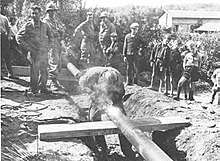
A workforce of over 7,200 troops and 1,500 prisoners of war was engaged in the construction of the Major System pipeline. Units involved included the 358th, 359th and 368th Engineer General Service Regiments and a battalion of the 364th Engineer General Service Regiment, and nine petroleum distribution companies. Through lack of experience, the engineers were sometimes careless with the couplings or left gaps that permitted the entry of animals or into which troops threw C-ration cans. In the attempt to push the pipeline ahead as quickly as possible, the engineers did not always take the time to break through hedgerows or clear minefields, and lines were often laid along road shoulders, where they were subject to damage by motor vehicles. The line was also subject to acts of sabotage, and black marketeers sometimes punched holes in it in order to steal fuel.[41][42]
Breaks in the line on 29 August forced truck units to draw MT80 from Saint-Lô, 80 miles (130 km) further away. Up to this point the pipeline had overriding priority, but its construction required the railway system to deliver 500 to 1,500 long tons (510 to 1,520 t) of pipes, tanks, pumps and fittings each day. By the end of August, one Major System MT80 pipeline had reached Alençon, another was at Domfront, and an avgas pipeline had nearly reached Domfront. By mid-September, the pipeline's priority was downgraded, and it had to rely on motor transport, limiting progress to 7 to 8 miles (11 to 13 km) per day. The pipeline reached Coubert on 6 October, and there it remained until January 1945.[41][42]
The COMZ salvage effort was concentrated under the 202nd Quartermaster Battalion, which had three collecting and three repair companies. Combat units collected their own salvage, which was picked up at the truckheads and hauled to the salvage depots in returning ration trucks. The repair companies were static, but had mobile equipment maintenance units that visited the forward areas. The collecting companies combed the rear areas looking for abandoned equipment.[43] By August, a shortage of jerricans had become a critical supply problem.[44] Over 2 million jerricans had been discarded or abandoned in Normandy.[40] Major General Robert McG. Littlejohn, the Chief Quartermaster, noted that the salvage companies and gasoline supply companies were ignoring the thousands of jerricans that littered the roads in the Le Mans area until he specifically ordered them to collect them. An even greater problem was the huge stockpiles of empty jerricans that had been abandoned at dumps when the units manning them had displaced forward.[44]
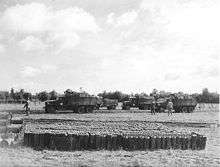
Littlejohn appointed Colonel Lyman R. Talbot, the chief the COMZ Petroleum and Fuel Division, as his special POL liaison officer at ADSEC,[40] with special responsibility for collecting jerricans. Since it was easier to move bulk POL to the jerrican dumps than to move the empty jerricans to the bulk POL, Littlejohn and Talbot established temporary filling points at the disused dumps.[44] Editorials urging that discarded cans be handed in were run in Stars and Stripes, the United States Information Service ran appeals in the news media, and French civilians, including children, were employed in the search for discarded jerricans. By the end of December, over one million discarded or abandoned jerricans had been recovered.[45]
Efforts were made to procure more jerricans. The War Office agreed to supply 221,000 per month, about half what Littlejohn estimated was required. Orders were placed in the United States, but production there had ceased, and efforts to restart it were hampered by a shortage of manpower. Shipping was also a problem, as the tonnage allocated to quartermaster items had been reduced, and Littlejohn needed shipping space for winter clothing. Jerricans had to be sent as filler or deck cargo. The number of decanting sites was reduced to minimize the reserves of cans. Finally, due to the shortage of jerricans, each army was forced to accept part of its POL allocation in bulk, or in 55-US-gallon (210 l) drums. These weighed 412 pounds (187 kg) when filled with gasoline, and were disliked by the combat troops, who had little access to handling equipment at their forward dumps, and the regarded them as inconvenient and dangerous.[45]
Railways

The Overlord planners intended to use rail transport for most long-distance haulage. France had a good rail network, with nearly 36,500 miles (58,700 km) of single- and double-track lines. Like most European railway systems, the rolling stock was lightweight and loading and unloading facilities were limited, so rolling stock coming from the United States had to be specifically designed and built for the purpose of operating on the continent. Railway units were scheduled to arrive at Cherbourg, but the delay in capturing and then opening the port meant that the first units arrived over the beaches. The first rolling stock, two 150-horsepower (110 kW) diesel locomotives and some flatcars, arrived on LCTs that were unloaded over Utah Beach on 10 July.[46][47]
Later that month the seatrains USAT Seatrain Texas and Seatrain Lakehurst began delivering rolling stock to Cherbourg. The port was still too badly damaged for them to be berthed, so they were unloaded in the stream, with rolling stock transferred to barges that were unloaded on the shore with the aid of mobile cranes. While the seatrains brought in the heavier equipment like locomotives and tank cars, most rolling stock arrived on LSTs fitted with rails. By 31 July 1944, 48 diesel and steam locomotives and 184 railway cars had arrived from the United Kingdom, and another 100 steam locomotives, 1,641 freight cars, and 76 passenger cars had been captured.[46][47]
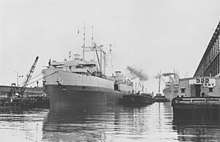
The commander of the 2nd Military Railway Service, Brigadier General Clarence L. Burpee, arrived in Normandy on 17 June, and by the end of July the 707th Railway Grand Division had the 720th, 728th and 729th Railway Operating Battalions and the 757th Shop Battalion operational.[48] French civilian railway workers were employed whenever possible. Railway operations commenced in early July. Major General Frank S. Ross, the ETO Chief of Transportation, rode the line from Cherbourg to Carentan in a jeep equipped with flanged wheels.[47] Immediately after Operation Cobra began, the 347th Engineer General Service Regiment was withdrawn from its work on the port of Cherbourg and set to work rehabilitating the railway lines, which had been badly damaged by the Allied Air Forces. It started by repairing the masonry bridge over the Vire River on the Saint-Lô line, constructing a timber trestle bridge to replace a missing span. At Coutances, it replaced a missing span of a viaduct bridge. Reconstruction of the marshalling yards at Saint-Lô was a major task, as they had been almost completely destroyed.[49]
On 12 August, the Third Army asked for the line to Le Mans to be opened, with 12,000 long tons (12,000 t) of ammunition and POL to be delivered over the next three days. The main line eastward from Vire to Argentan was still in German hands, and the one southward to Rennes and then eastward to Le Mans could not be restored quickly because major bridge reconstruction tasks were required at Pontaubault and Laval. Instead, a temporary route was found using a series of secondary lines while the main line was being repaired. Even this required some major bridge reconstruction work, notably an 80-foot (24 m) single-track bridge at Saint-Hilaire-du-Harcouët. Elements of no less than eleven engineer general service regiments worked on the lines simultaneously. When Major General Cecil R. Moore, the ETO Chief Engineer flew over the Saint-Hilaire bridge site at 18:00 on 15 August, he saw a sign on the ground in white cement that read: "Will finish at 20:00." The first train loaded with POL left Folligny at 19:00, crossed the bridge at around midnight, and, after many delays, rolled into Le Mans on 17 August. Thirty more trains followed at half-hour intervals.[50][51]
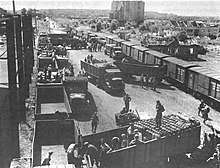
With only single-track lines in use, the lines between Avranches and Le Mans soon became congested, and a shortage of empty freight cars developed. The rail yards at Folligny and Le Mans were badly damaged, and considerable reconstruction work was required. Getting the main line east of Rennes in use required the repair of the bridge at Laval, which was completed by the end of the month. By mid-August, the main line to Argentan was in Allied hands. Its reconstruction was given a high priority, and it was in use by the end of the month. Beyond Chartres, the lines were badly damaged, as the Allied Air Forces had given particular attention to interdicting German lines of communications across the Seine. By the end of August, 18,000 men, including 5,000 prisoners of war, were working on railway reconstruction. An American train reached the rail yards at Batignolles in Paris on 30 August by using a circuitous route, but its use was initially restricted to hospital trains, engineer supplies, and civil affairs relief. Nearly all the Seine bridges had been destroyed, and by 4 September only two or three trains per day navigated the Paris bottleneck to points beyond. Dreux and Chartres remained the forward railheads of the First and Third Armies respectively.[52]
Beyond the Seine, the railway network was more extensive, and damage was much lighter, as in had not been the target of air attack nearly as much as the railways in the Normandy lodgement area, and the Germans had not had time to destroy them. The main problem was shortage of rolling stock. Transfer points were established in the Paris area where supplies were transferred to railway cars, taking some of the burden off the hard-pressed motor transport resources. By mid-September, 3,400 miles (5,500 km) of track had been rehabilitated and over forty bridges had been rebuilt. Lines had been opened north of Paris to Namur and Liege in Belgium to support the First Army, and eastward to Verdun and Conflans-en-Jarnisy to support the Third Army. By mid-September, the railways were hauling 2,000,000 ton-miles per day, and rail tonnages north of the Seine averaged only 5,000 long tons (5,100 t) per day.[53]
Motor transport
With the railways and pipelines unable to keep up with the pace of the advance, the breakout and pursuit from Normandy placed a heavy burden on ADSEC's Motor Transport Brigade. Yet even before Operation Cobra began, COMZ estimated that there would be a shortage of 127 truck companies by D plus 90.[54] This was a consequence of decisions made in the planning stages of Overlord. COMZ had estimated that 240 truck companies were required, but only 160 were approved in November 1943.[55] ETOUSA was only partly responsible for this. In peacetime, the vaunted American motor vehicle industry had produced about 600 heavy-duty trucks (defined as 4-ton vehicles or greater) a month, but in July 1943, the ASF ordered 67,000 to be produced in 1944. The Truman Committee considered this wasteful, unnecessarily reducing the number of civilian trucks that could be built. Despite the adverse political pressure, the Army pressed on with the production program, but in January 1944, only 2,788 heavy-duty trucks came off the assembly lines.[56]
Ross wanted two-thirds of the ETO's requested 160 companies equipped with the 10-ton semi-trailer, which was especially suitable for long-distance haulage, with the rest equipped with 2½-ton 6x6 trucks for shorter inter-depot movements and clearance of railheads, but by the end of March 1944, ETO had only 66 10-ton semi-trailers instead of the 7,194 it had requested, and none of the 4,167 4- or 5-ton truck tractors. In April, the War Department attempted to meet the requirements by taking hundreds of trucks of miscellaneous types from the ASF, Army Ground Forces and Army Air Forces in the United States, and ASF diverted 1,750 4- and 5-ton truck tractors and 3,500 5-ton semi-trailers earmarked for the Ledo Road project in Burma to the ETO.[57]

The tardy delivery of vehicles affected the training of the personnel of motor transport units. As with many other service units, the ETO had been compelled to accept partially trained units in the hope of their being able to complete their training in the UK. The late arrival of vehicles meant that this training could not get under way until May 1944. In August 1943 the Transportation Corps recommended that each truck company be allocated an additional 36 drivers, bringing them up to two per vehicle and 96 per company, thereby allowing the trucks to be operated around the clock. ETOUSA disapproved this, which it regarded as unnecessary, but nonetheless the Transportation Corps persisted, and in early 1944 Lee had approved the proposal.[58]
But by this time the War Department had established a troop ceiling for the ETO, and would not provide the additional personnel without corresponding cuts elsewhere, so the 5,600 men to provide an additional 40 drivers for 140 companies had to be obtained from other SOS units. Lee sternly warned that he would not countenance this being used as an excuse to rid units of undesirables. Whether this admonition worked is debatable, but insufficient numbers of personnel were provided, so in May 1944, fourteen African-American truck companies had their personnel transferred to other African-American units. The intention was to replace them with Caucasian personnel, but the numbers were not made available. Instead, two engineer general service regiments were temporarily converted to truck units. The cost of inadequate training of truck drivers would be paid in avoidable damage to vehicles through accidents and poor maintenance.[58]

On 10 August, two companies of 45-ton tank transporters were converted to cargo carriers. A few days later, the 55 truck companies equipped with 2½-ton 6x6 trucks were each given ten additional trucks, and three British truck companies were borrowed from the 21st Army Group. The situation became acute with the decision to continue the pursuit across the Seine. COMZ estimated that this would require 100,000 long tons (100,000 t) of supplies (excluding POL) to be delivered to the Dreux-Chartres area by 1 September. Of this, the railways could deliver only 18,000 long tons (18,000 t), leaving 82,000 long tons (83,000 t) to be hauled by the Motor Transport Brigade. It was immediately realized that this would require an extraordinary effort.[59]
The solution adopted was the Red Ball Express, a term appropriated from the railways. The plan called for a one-way highway loop running around the clock. This expedient had never been attempted before and the procedures for operating it were untried. Routes were marked with Red Ball markers. Red Ball convoys commenced on 25 August, and reached their peak on 29 August when 132 companies with 5,958 vehicles delivered 12,342 long tons (12,540 t) of supplies. They moved at a maximum speed of 25 miles per hour (40 km/h) with 60 yards (55 m) between each vehicle and no overtaking was permitted. An hourly ten-minute break was taken at ten minutes before the hour. Opposition from the Luftwaffe was absent, permitting the use of lights at night. In practice, convoy discipline, especially with regard to speed limits, was not always followed. Without adequate numbers of military police to control the routes, it proved impossible to reserve them for the exclusive use of the Red Ball Express. Congestion resulted when the routes were also used by the First and Third Armies and the Ninth Air Force, with military and civilian vehicles sometimes attempting to move against the flow of Red Ball traffic. The deadline was not met, but by 5 September 89,000 long tons (90,000 t) had been delivered to the Dreux-Chartres area.[59]
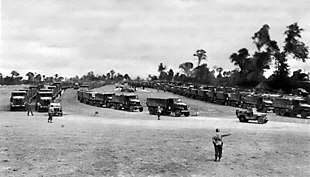
Although this ended its original mission, the Red Ball Express continued to operate until the end of September, with deliveries further afield to Soissons and Hirson in support of the First Army and Fontainebleu and Sommesous in support of the Third Army.[60] From 16 September to 12 October, eight companies, six of which were equipped with 2½-ton 6x6 trucks and two with 10-ton semi-trailers, were withdrawn from the Red Ball Express to run a series of Red Lion convoys. These delivered 18,000 long tons (18,000 t) to the 21st Army Group, half of which went to the 82nd and 101st Airborne Divisions. The eight companies were replaced by provisional companies formed from the personnel and vehicles of the newly arrived 26th, 95th, and 104th Infantry Divisions.[61]
The achievements of the Red Ball Express came at a high price. It consumed 300,000 US gallons (1,100,000 l) of MT80 a day.[62] Drivers drove their vehicles at twice the 25 miles (40 km) speed limit, and trucks carried double their nominal loads. The practice of overloading vehicles had the official sanction of the War Department, but testing of this had been carried out at the Aberdeen Proving Ground, and conditions in France were more grueling. Consumption of the most common type of tire, the 750 x 20 8-ply, rose from an average of 29,142 per month from June to August to 55,059 in September. By 9 October, there were only 2,000 spares on the continent and 46,596 left in the UK. Nearly two thirds of the loss of tires was attributable to running over carelessly discarded C-ration cans that littered the roads. Vehicles were run without proper maintenance, and dry batteries, lack of oil and loose nuts and bolts caused breakdowns. Driver fatigue was also a factor; round trips sometimes went for 48 to 65 hours. In one convoy, eight semi-trailers hauling gasoline went over an embankment. The following day, eight 2½-ton trucks repeated this feat at the same location. Ordnance personnel noted instances of vehicles that had been sabotaged. By the end of September, 5,750 vehicles required major repairs.[63][64]
Air supply
To relieve pressure on the over-burdened Motor Transport Brigade, recourse was made to air supply. Although fast and flexible, air supply had many disadvantages, the main one being low tonnage capacity, but the variable availability of transport aircraft, their vulnerability to enemy fighters, and their susceptibility to bad weather were also limiting factors.[65] On 10 and 11 August the 2nd Battalion, 120th Infantry, isolated by the German counterattack at Mortain, received supplies by air drop.[66]
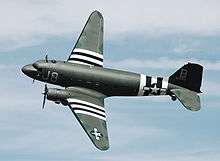
On 15 August, SHAEF made available an allocation of air transport capable of delivering up to 2,000 long tons (2,000 t) per day to the Le Mans area. Deliveries to a newly opened air field there began on 19 August. Due to bad weather and problems with the airfield, an average of 600 long tons (610 t) per day was delivered over the following week. By 22 August, there were 383 fully-loaded C-47 transport aircraft in the UK awaiting despatch. The problem was a lack of suitable landing fields. Rehabilitating captured German airfields or building new ones required the movement of engineer stores using scarce motor transport. 12th Army Group allocated 2,100 long tons (2,100 t) per day to such stores during the pursuit, but the Ninth Air Force gave priority to forward fighter airfields.[67] The early capture of Paris on 25 August forced Eisenhower to allocate 500 long tons (510 t) per day to civil relief supplies, mainly food, medical supplies and soap.[68]
Deliveries by air peaked at 2,900 long tons (2,900 t) (including 500 long tons (510 t) to Paris) on 26 and 27 August, but then tailed off as the C-47s were withdrawn for airborne operations on 29 August. To make up for them, the United States Strategic Air Forces made 100 Consolidated B-24 Liberator aircraft available, which had to be modified to carry cargo, but these required longer air fields and increased intervals between landings. During the week of 27 August to 2 September, 4,470 long tons (4,540 t) was delivered by air, of which 443 long tons (450 t) was carried by B-24s, but only 1,877 long tons (1,907 t) was delivered to the 12th Army Group; 917 long tons (932 t) went to 21st Army Group and 1,676 long tons (1,703 t) to Paris. On 3 September, SHAEF ordered the First Allied Airborne Army to release 600 C-47s for air supply duties. On 14 September they were again withdrawn, for Operation Market Garden. Between 20 August and 16 September, 23,216 long tons (23,589 t) of supplies were delivered by air, of which 12,799 long tons (13,004 t) went to the 12th Army Group, 7,766 long tons (7,891 t) to the 21st Army Group, and 2,651 long tons (2,694 t) to Paris.[69] From 18 September, B-24s began shipping POL in bulk because the stock of jerricans in the UK had nearly been exhausted. By the end of the month, over 2,500,000 US gallons (9,500,000 l) had been delivered this way.[70]
Ports
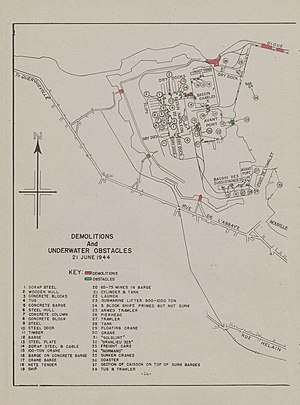
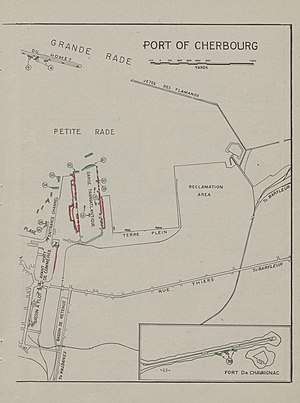
The first deep water port captured by the Allies was Cherbourg, which fell on 26 June. An advance party surveyed the port the following day. The Cherbourg Maritime station, the main railway station, was badly damaged, as were the two main quays, the Quai Normandie and the Quai de France.[71][72] The Digue du Homet, a 3,300-by-70-foot (1,006 by 21 m) mole, had two 100-foot (30 m) wide craters in it. The western breakwater of the inner port, the Petite Rade, was severed by two large craters, and the berth for coal coasters, the Quai Homet, had nine 40-to-50-foot (12 to 15 m) craters.[73]
The entrances to the three basins were obstructed by sunken ships and barges, and the basins themselves were filled with sunken barges, tugs, coasters and trawlers. The German naval commander in Cherbourg, Rear Admiral Walter Hennecke, now a prisoner of war, was awarded the Knight's Cross of the Iron Cross for the demolition of the port, but the damage was not as extensive as the Germans believed. The demolitions had been prepared well in advance, but the final phase had not been carried out, presumably because the personnel responsible were killed or captured when the city fell.[71][72]
Rehabilitation work was undertaken by the 1056th Port Construction and Repair Group, with the 332nd and 342nd Engineer Regiments and the 333rd Engineer Special Service Regiment assigned. The first priority was creating a landing site for DUKWs on the Nouvelle Plage, a bathing beach. This was ready on 6 July, but the DUKWs could not come ashore because the Grande and Petite Rades had been sown with mines.[74]
Twenty US Navy coastal minesweepers and the British 9th and 159th Minesweeping Flotillas were engaged in mine clearance. Many of the mines were of a delayed action kind that only became active after a set number of days. Eight acoustic and eight magnetic sweeps were conducted every morning for 85 days. By 13 July, 133 mines had been swept, of which 86 were magnetic or acoustic. This did not include the small concrete-encased coastal mines KMA (kustenmine-A), known as "Katie mines", sown in shallow waters that had to be removed by divers. Three minesweepers were lost to mines, as were some small craft and barges.[75][76][77][78] The first four Liberty ships entered the Grande Rade in 16 July, and were unloaded at anchor into DUKWS.[72]

The 332nd Engineer General Service Regiment filled in the craters in the Digue du Homet, and repaired the road and railway lines leading to it. Two berths were prepared for Twickenham ferries, British vessels built to carry locomotives and rolling stock. The first arrived on 29 July with several 65-long-ton (66 t) diesel electric locomotives and rolling stock. The first Liberty ship docked there on 9 August. Getting the naval base working to accommodate Liberty ships involved repairing demolished bridges. It ultimately provided eleven berths for Liberty ships. The wreckage of the Gare Maritime was found to contain twenty-four freight cars loaded with mines the German had apparently not had time to detonate. These were carefully deactivated and removed.[72]
On 10 August, the port repair ship Junior N. Van Noy, a converted Great Lakes steamer named after Junior Van Noy, an engineer posthumously awarded the Medal of Honor in the Battle of Finschhafen, arrived with specialized salvage equipment. An access channel to the Darse Transatlantique was cleared of debris and mines by 18 September, and the first Liberty ship docked there on 8 October.[72] By September, Cherbourg was the second largest port supporting the US forces after Marseilles. Between 16 July and the end of the war, it handled 2,137 ships, which discharged 2,816,740 long tons (2,861,940 t) of cargo and 130,210 passengers. In addition, 307,939 passengers were embarked, including 124,206 German prisoners of war and 148,753 wounded Allied soldiers.[78]
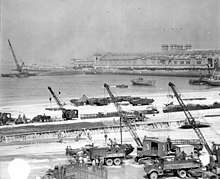
The first port captured in the breakout was Granville on 31 July. Like Cherbourg, it had been subject to systematic demolition, with quays cratered, cranes tipped into the water, and the harbor blocked with sunken craft. Rehabilitation was undertaken by the 1055th and 1058th Port Construction and Repair Groups. It was operated solely as a coal port, and averaged 1,244 long tons (1,264 t) per day from when it was opened on 18 September until it closed on 21 April 1945.[79]
Rouen on the tidal Seine was captured on 30 August, but was not usable until downstream Le Havre was taken on 12 September. Le Havre, the second largest port in France, was heavily damaged not just by German demolitions but by Allied land, sea and aerial bombardment. Moreover, an American line of communications from Le Havre would cross that of the British. Accordingly, it was decided not to attempt its complete rehabilitation. The first vessels entered Le Havre on 2 October, but mines and obstructions limited it to landing craft and coasters until 13 October, when the first Liberty ship was able to dock. Coasters carrying POL began discharging at Rouen on 15 October. Antwerp, one of the world's largest ports, was captured largely intact on 4 September, but could not be used until the Scheldt estuary was cleared and the sluice gates were repaired. The first American Liberty ship did not dock there until 28 November.[79]
Outcome
On 4 September Montgomery put a proposal to Eisenhower. He contended that a simultaneous advance on both the Ruhr and the Saar regions, as contemplated in the original Overlord plan, was not logistically feasible. He therefore recommended that the maximum resources be concentrated on the advance on the Ruhr, and then towards Berlin, which could best be supported, and was most likely to produce results. In his response the following day, Eisenhower rejected this. Assuming that the bulk of the German army in the West had been destroyed, and that an advance on Berlin was logistically infeasible, he decided to continue with the original plan and advance on a broad front, capturing both the Ruhr and the Saar. Eisenhower suggested that the ports of Le Havre and Antwerp would be opened during the advance,[80] but the former was not yet in Allied hands, and while the latter had been captured on 4 September,[81] it was not expected to be opened before 1 November.[82] This became known as the broad front controversy, and was the subject of much debate in the post-war years.[83]
.jpg)
Subsequent events demonstrated that Eisenhower's decision was the wrong one; the German army in the West was not destroyed and neither the Ruhr nor the Saar was reached in 1944. It is possible that the Ruhr could have been reached had Montgomery's proposal been adopted. The British axis in the north involved an advance of 105 to 115 miles (169 to 185 km). It could be supported by ports that were captured such as Dieppe, Boulogne and Ostend, and there were good rail links that supplied much of 21st Army Group's needs.[84] Bradley and Patton advocated an advance on the Saar that ignored logistical considerations. They contended that this southern axis was less well defended than the northern one, and there was good reason for that. The advance would have captured no ports, so logistic support would have depended almost entirely on an extended version of the Red Ball Express. The terrain was rugged, and given the strain on personnel and the wear and tear on vehicles, the advance would have been difficult to sustain. Acts of sabotage were likely as the advance entered Germany, as was interference by the Luftwaffe once it was beyond the range of fighter cover.[85][86]
Lieutenant Colonel Harold L. Mack, who served on the COMZ staff, described the failure to implement Operation Chastity as the "Critical Error of World War II",[87] but historian Russell Weigley regarded the commitment to Brittany as wasteful of resources that would have been better spent supporting the drive to the east. Although Bradley's decision entailed grave risk, the US Army's logistical difficulties in the pursuit were not a result of inadequate port resources—in November there were still some 600,000 long tons (610,000 t) of supplies stockpiled in the Normandy lodgment area. Rather, the problem was the inability to deliver them.[88][89] Nor was the pursuit halted solely by a shortage of POL. The pursuit resulted in large quantities of equipment being damaged, worn out, and written off. In November, SHAEF reported to the War Department that each month, 700 mortars, 375 medium and 125 light tanks, 900 2½-ton trucks, 1,500 jeeps, and 100 artillery pieces had been written off. Tank losses in August and September respectively had been 25.3 percent and 16.5 percent of establishment, and the reserves were exhausted. Over 15,000 vehicles were deadlined, awaiting repairs or parts.[89]
When the army commanders and their staffs ran into foreseeable logistical difficulties, they blamed each other, they blamed COMZ, and they blamed the British.[89] In December 1944, the Chief of Army Service Forces, Lieutenant General Brehon B. Somervell sent his Director of Operations, Major General LeRoy Lutes, to study the ETO's difficulties. He found that the army commanders had little confidence in COMZ, and that they had little logistical acumen. Lutes credited the commander of the Ninth Army, Lieutenant General William H. Simpson, with the best understanding of logistics.[90] Lutes noted that the First Army's commander, Lieutenant General Courtney Hodges, was "a man intolerant of supply shortcomings, who has not studied supply and does not intend to".[91] Given that Bradley, Hodges, Patton and Simpson had all attended the Command and General Staff College and Army War College,[92] this pointed to a deficiency in the Army's training of senior officers.[90]
The battle of Normandy had been won, but there remained a lingering impression that even more could have been accomplished, given the resources available. The supply shortages that occurred were not invariably the fault of COMZ; many had their origins back in the United States. Nonetheless, the logistical plan lacked the flexibility needed to cope with a rapidly changing operational situation.[93] The logistical system was pushed to breaking point when senior commanders subordinated logistical imperatives to operational opportunities. The decision to continue the pursuit beyond the Seine had long-term and far-reaching effects in the form of the attrition of equipment, failure to establish a proper supply depot system, neglect of the development of ports, and inadequate stockpiles in forward areas, all of which were exacerbated by the poor supply discipline of the American soldier. These factors would be keenly felt over the months to come.[94] Historian Roland Ruppenthal concluded that in the end, "operations, to paraphrase an old maxim, had definitely become the art of the logistically feasible."[95]
Notes
- Waddell 1994, pp. 1–4.
- Waddell 1994, pp. 13–15.
- Ruppenthal 1953, p. 206.
- Ruppenthal 1953, p. 457.
- Ruppenthal 1953, pp. 211–213.
- Waddell 1994, pp. 16–20.
- Waddell 1994, p. 29.
- Ruppenthal 1953, p. 189.
- Waddell 1994, pp. 25, 46–48.
- Waddell 1994, pp. 60–61.
- Waddell 1994, pp. 80–84.
- Pogue 1954, p. 204.
- Pogue 1954, pp. 183.
- Pogue 1954, pp. 264–265.
- Ruppenthal 1953, p. 483.
- Mack 1981, p. 8.
- Blumenson 1961, p. 364.
- Rawson 2012, p. 117.
- Blumenson 1961, pp. 414–415.
- Blumenson 1961, p. 653.
- Blumenson 1961, p. 655.
- Ruppenthal 1951, p. 4.
- Ruppenthal 1953, pp. 484–485.
- Ruppenthal 1951, p. 5.
- Ruppenthal 1953, pp. 434–436.
- Ruppenthal 1959, p. 31.
- Ruppenthal 1959, p. 34.
- Ruppenthal 1953, pp. 436–437.
- Dick 2016, p. 286.
- Pogue 1954, pp. 322–323.
- Ruppenthal 1959, pp. 33–35.
- Ruppenthal 1953, p. 493.
- Ruppenthal 1953, pp. 494–496.
- Ruppenthal 1953, pp. 504–509.
- Ruppenthal 1953, pp. 501–502.
- Waddell 1994, pp. 62–63.
- Ruppenthal 1953, p. 510.
- Beck et al. 1985, p. 409.
- Ross & Romanus 1965, p. 651.
- Ross & Romanus 1965, pp. 651–652.
- Ruppenthal 1953, pp. 511–515.
- Beck et al. 1985, pp. 411–413.
- Ross & Romanus 1965, p. 462.
- Ross & Romanus 1965, p. 664.
- Ross & Romanus 1965, pp. 665–666.
- Ruppenthal 1953, pp. 544–546.
- Bykofsky & Larson 1957, pp. 285–287.
- DeNevi & Hall 1992, pp. 83–84.
- Beck et al. 1985, p. 399.
- Ruppenthal 1953, p. 547.
- Beck et al. 1985, pp. 400–401.
- Ruppenthal 1953, pp. 547–550.
- Ruppenthal 1953, pp. 550–553.
- Ruppenthal 1953, pp. 481–482.
- Ruppenthal 1953, pp. 553–554.
- Thomson & Mayo 1960, pp. 287–289.
- Ruppenthal 1953, pp. 553–555.
- Ruppenthal 1953, pp. 556–557.
- Ruppenthal 1953, pp. 558–564.
- Ruppenthal 1953, p. 567.
- Ruppenthal 1959, pp. 139–140.
- Ruppenthal 1953, p. 509.
- Ruppenthal 1953, p. 571.
- Waddell 1994, p. 131.
- Ruppenthal 1953, pp. 572–573.
- Blumenson 1961, p. 489.
- Ruppenthal 1953, pp. 575–576.
- Blumenson 1961, p. 626.
- Ruppenthal 1953, pp. 578–582.
- Ross & Romanus 1965, p. 656.
- Crist 1945, pp. 12–13.
- Beck et al. 1985, pp. 352–353.
- Crist 1945, pp. 23–24.
- Beck et al. 1985, pp. 353–354.
- Melia 1991, p. 58.
- Harrison 1951, p. 262.
- Roskill 1961, p. 70.
- Morison 1957, pp. 216–218.
- Beck et al. 1985, pp. 359–364.
- Rawson 2012, pp. 138–139.
- Blumenson 1961, p. 686.
- Ruppenthal 1951, p. 8.
- Ruppenthal 1960, p. 420.
- Dick 2016, pp. 296–297.
- Dick 2016, pp. 295–296.
- Pogue 1954, pp. 258–259.
- Mack 1981, pp. 1–3.
- Waddell 1994, p. 133.
- Dick 2016, p. 292.
- Ruppenthal 1959, pp. 348–349.
- Hogan 2000, p. 165.
- Ancell & Miller 1996, pp. 30, 153, 252, 297.
- Waddell 1994, pp. 164–165.
- Ruppenthal 1959, p. 509.
- Ruppenthal 1960, p. 428.
References
- Ancell, R. Manning; Miller, Christine (1996). The Biographical Dictionary of World War II Generals and Flag Officers: The US Armed Forces. Westport, Connecticut: Greenwood Press. ISBN 0-313-29546-8. OCLC 231681728.CS1 maint: ref=harv (link)
- Beck, Alfred M.; Bortz, Abe; Lynch, Charles W.; Mayo, Lida; Weld, Ralph F. (1985). The Corps of Engineers: The War Against Germany (PDF). United States Army in World War II – The Technical Services. Washington, DC: Center of Military History, United States Army. OCLC 40485571. Retrieved 1 June 2017.CS1 maint: ref=harv (link)
- Blumenson, Martin (1961). Breakout and Pursuit (PDF). United States Army in World War II – The European Theater of Operations. Washington, DC: Center of Military History, United States Army. OCLC 1253744. Retrieved 4 March 2020.CS1 maint: ref=harv (link)
- Bykofsky, Joseph; Larson, Harold (1957). The Transportation Corps: Operations Overseas (PDF). United States Army In World War II – The Technical Services. Washington, DC: Center of Military History, United States Army. OCLC 867377092. Retrieved 9 July 2020.CS1 maint: ref=harv (link)
- Crist, Joseph A (1945). Cherbourg Port Reconstruction (PDF). APO 887: Headquarters, Communications Zone, Office of the Chief Engineer. OCLC 44157105. Retrieved 6 February 2020.CS1 maint: location (link) CS1 maint: ref=harv (link)
- DeNevi, Don; Hall, Bob (1992). United States Military Railway Service. Toronto: Stoddart. ISBN 1-55046-021-8. OCLC 30320648.CS1 maint: ref=harv (link)
- Dick, C. J. (2016). From Victory to Stalemate – Decisive and Indecisive Military Operations, Volume 1. Lawrence, Kansas: University Press of Kansas. ISBN 978-0-7006-2293-1. OCLC 1023039366.CS1 maint: ref=harv (link)
- Harrison, Gordon A. (1951). Cross Channel Attack (PDF). United States Army in World War II – The European Theater of Operations. Washington, DC: Office of the Chief of Military History, United States Army. OCLC 78600975.CS1 maint: ref=harv (link)
- Hogan, David W., Jr. (2000). A Command Post at War: First Army Headquarters in Europe 1943–1945 (PDF). Washington DC: Center of Military History, United States Army. ISBN 0-16-049771-X. OCLC 43662157. CMH Pub 70-60. Retrieved 26 January 2020.CS1 maint: ref=harv (link)
- Mack, Harold L. (February 1981). "The Critical Error of World War II". National Security Affairs Issue Paper. Washington, DC: National Defense University. hdl:2027/uiug.30112074912624. OCLC 605367568. 81-1. Cite journal requires
|journal=(help)CS1 maint: ref=harv (link) - Melia, Tamara Moser (1991). Damn the Torpedoes: A Short History of U.S. Naval Mine Countermeasures, 1777–1991. Washington, DC: Naval Historical Center, Department of the Navy. ISBN 978-0-945274-07-0. OCLC 23694163.CS1 maint: ref=harv (link)
- Morison, Samuel Eliot (1957). The Invasion of France and Germany. History of United States Naval Operations in World War II. XI. Boston: Little, Brown and Company. OCLC 671874345.CS1 maint: ref=harv (link)
- Pogue, Forrest (1954). The Supreme Command (PDF). United States Army in World War II – The European Theater of Operations. Washington, DC: Center of Military History, United States Army. LCCN 53-61717. OCLC 1247005.CS1 maint: ref=harv (link)
- Rawson, Andrew (2012). Eyes Only: The Top Secret Correspondence Between Marshall and Eisenhower. Stroud, Gloucestershire: Spellmont. ISBN 978-0-7524-6290-5. OCLC 759584447.CS1 maint: ref=harv (link)
- Roskill, Captain S. W. (1961). The War at Sea, Volume III: The Offensive, Part II: 1 June 1944 – 14 August 1945. History of the Second World War. London: HMSO. OCLC 491558590.CS1 maint: ref=harv (link)
- Ross, William F.; Romanus, Charles F. (1965). The Quartermaster Corps: Operations in the War Against Germany (PDF). Washington, DC: Center of Military History, United States Army. OCLC 56044302. Retrieved 23 February 2020.CS1 maint: ref=harv (link)
- Ruppenthal, Roland G. (August 1951). "Logistic Limitations on Tactical Decisions". Military Review. XXXI (5): 3–9. ISSN 0026-4148. Retrieved 11 March 2020.CS1 maint: ref=harv (link)
- Ruppenthal, Roland G. (1953). Logistical Support of the Armies (PDF). United States Army in World War II – The European Theater of Operations. Volume I, May 1945 – September 1944. Washington, DC: Center of Military History, United States Army. OCLC 640653201. Retrieved 14 July 2019.CS1 maint: ref=harv (link)
- Ruppenthal, Roland G. (1959). Logistical Support of the Armies (PDF). United States Army in World War II – The European Theater of Operations. Volume II, September 1944 – May 1945. Washington, DC: Center of Military History, United States Army. OCLC 8743709. Retrieved 6 March 2020.CS1 maint: ref=harv (link)
- Ruppenthal, Roland G. (1960). "Logistics and the Broad-Front Strategy". In Greenfield, Kent Roberts (ed.). Command Decisions. Washington, DC: Center of Military History, United States Army. pp. 419–428. OCLC 772563480. Retrieved 11 March 2020.CS1 maint: ref=harv (link)
- Thomson, Harry C.; Mayo, Lida (1960). The Ordnance Department: Procurement and Supply (PDF). United States Army in World War II – The Technical Services. Washington, DC: Center of Military History, United States Army. OCLC 89462. Retrieved 9 July 2020.CS1 maint: ref=harv (link)
- Waddell, Steve R. (1994). United States Army Logistics: The Normandy Campaign. Contributions in Military Studies, No. 155. Westport, Connecticut ; London: Greenwood Press. ISBN 0-313-29054-7. OCLC 467960939.CS1 maint: ref=harv (link)
